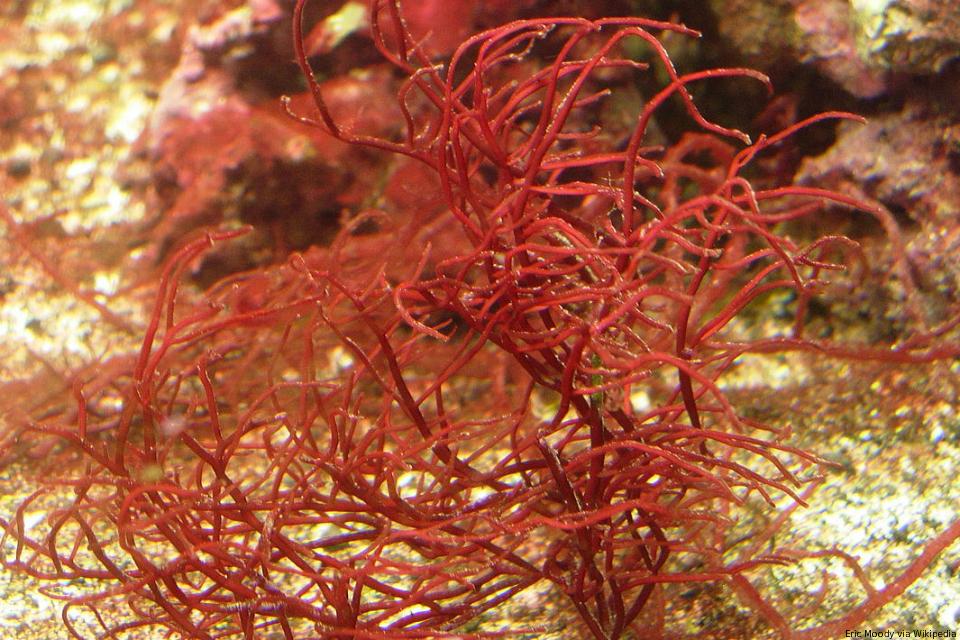Irradiated 'gulaman' can help boost PHL rice production
 Gracilaria edible red seaweed, from which carrageenan or "gulaman" is extracted. Eric Moody via Wikipedia
Gracilaria edible red seaweed, from which carrageenan or "gulaman" is extracted. Eric Moody via WikipediaExtracts from seaweeds, with a little tweak of gamma irradiation, can increase rice production by about a third and guard against major pests.
Scientists at the Philippine Nuclear Research Institute (PNRI) have developed the carrageenan plant food supplementor (CPFS), which is derived from carrageenan extracted from red edible seaweeds. Carageenan—known locally as "gulaman"—is widely used for its gelling, thickening and stabilising properties in the food industry and as a binder in toothpaste and shampoo.
In a study published in Radiation Physics and Chemistry this January, the PNRI scientists showed that carrageenan-derived polysaccharide, a carbohydrate, enhances rice growth when degraded through a “very small dose” of gamma radiation.
Plant food supplements are substances that improve the overall health, growth and development of plants, says lead researcher Lucille Abad, chief of PNRI’s chemistry research section.
The agricultural benefits of carrageenan are achieved from its building blocks: the long-chain carrageenan polymer that can be broken down into shorter chain fragments known as oligomers (“oligo” for few), Abad explains. These oligomers are readily absorbed by the plant to help their growth and development and also improve their resistance to diseases.
“Using gamma radiation, we were able to cut up the polymer into oligomers without using chemicals or complicated and expensive processes,” she says.
“CPFS can be made with nothing more than the organic carrageenan and water processed by gamma radiation. The product that is formed is not and can never be radioactive. It is a clean and additive-free method that is safe, non-toxic, environment friendly and, most of all, effective.”
Abad says the CPFS formulations will be registered with the Philippines’ Fertilizer and Pesticide Authority as soon as results are verified from field trials in around 37,000 hectares nationwide for two planting seasons.
Once adopted by farmers, the new technology may boost rice production by at least 30 per cent. However, in one experiment in Bulacan province which is near Metro Manila, results showed a 65 per cent increase.
Gil Magsino, a scientist at the National Crop Protection Center and who headed the field trials conducted in Bulacan says three bags of chemical fertiliser per hectare combined with 200 parts per million or 20 milliliters per litre of CPFS yielded higher rice grain weight of 450 grams per 10 hills (mound of soil that is planted with seeds).
In contrast, conventional farmers’ practice of applying nine bags of chemical fertiliser per hectare yields a grain weight of only 275 grams per 10 hills.
Abad and her research team first tested the CPFS in pot experiments inside greenhouses at PNRI. Various concentrations were sprayed on the leaves of rice. Results showed rice stems and the length of the panicles that bear the grains were significantly higher in the test crops compared with conventional crops. CPFS also induces resistance against rice tungro virus and bacterial leaf blight, both major rice pests.
The CPFS was also sprayed on Chinese cabbage, mungbean and peanut, resulting in a product yield of as much as 200-300 per cent in the vegetables.
“Apparently, spraying the CPFS enhanced the presence of friendly insects such as ladybird beetles and spiders that help control harmful insects like the brown plant hoppers and green leaf hoppers,” Abad notes. — SciDev.Net
References
Lucille V. Abad and others Characterization of low molecular weight fragments from gamma irradiated κ-carrageenan used as plant growth promoter (Radiation Physics and Chemistry, January 2016)




